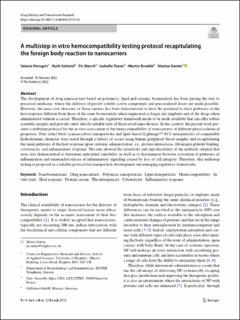| dc.contributor.author | Perugini, Valeria | |
| dc.contributor.author | Schmid, Ruth | |
| dc.contributor.author | Mørch, Ýrr Asbjørg | |
| dc.contributor.author | Texier, Isabelle | |
| dc.contributor.author | Brodde, Martin | |
| dc.contributor.author | Santin, Matteo | |
| dc.date.accessioned | 2022-06-17T08:13:29Z | |
| dc.date.available | 2022-06-17T08:13:29Z | |
| dc.date.created | 2022-04-10T15:50:26Z | |
| dc.date.issued | 2022 | |
| dc.identifier.citation | Drug Delivery and Translational Research. 2022, 1-12 . | en_US |
| dc.identifier.issn | 2190-393X | |
| dc.identifier.uri | https://hdl.handle.net/11250/2999230 | |
| dc.description.abstract | The development of drug nanocarriers based on polymeric, lipid and ceramic biomaterials has been paving the way to precision medicine, where the delivery of poorly soluble active compounds and personalized doses are made possible. However, the nano-size character of these carriers has been demonstrated to have the potential to elicit pathways of the host response different from those of the same biomaterials when engineered as larger size implants and of the drugs when administered without a carrier. Therefore, a specific regulatory framework needs to be made available that can offer robust scientific insights and provide safety data by reliable tests of these novel nano-devices. In this context, the present work presents a multistep protocol for the in vitro assessment of the hemocompatibility of nanocarriers of different physicochemical properties. Poly (ethyl butyl cyanoacrylate) nanoparticles and lipid-based (LipImage™ 815) nanoparticles of comparable hydrodynamic diameter were tested through a battery of assays using human peripheral blood samples and recapitulating the main pathways of the host response upon systemic administration; i.e., protein interactions, fibrinogen-platelet binding, cytotoxicity, and inflammatory response. The data showed the sensitivity and reproducibility of the methods adopted that were also demonstrated to determine individual variability as well as to discriminate between activation of pathways of inflammation and unintended release of inflammatory signaling caused by loss of cell integrity. Therefore, this multistep testing is proposed as a reliable protocol for nanoparticle development and emerging regulatory frameworks. | en_US |
| dc.language.iso | eng | en_US |
| dc.publisher | Springer | en_US |
| dc.rights | Navngivelse 4.0 Internasjonal | * |
| dc.rights.uri | http://creativecommons.org/licenses/by/4.0/deed.no | * |
| dc.subject | Inflammatory response | en_US |
| dc.subject | Cytotoxicity | en_US |
| dc.subject | Thrombogenicity | en_US |
| dc.subject | Protein corona | en_US |
| dc.subject | Host response | en_US |
| dc.subject | In vitro tests | en_US |
| dc.subject | Hemocompatibility | en_US |
| dc.subject | Lipid nanoparticles | en_US |
| dc.subject | Polymeric nanoparticles | en_US |
| dc.subject | Drug nanocarriers | en_US |
| dc.subject | Nanobiomaterials | en_US |
| dc.title | A multistep in vitro hemocompatibility testing protocol recapitulating the foreign body reaction to nanocarriers | en_US |
| dc.title.alternative | A multistep in vitro hemocompatibility testing protocol recapitulating the foreign body reaction to nanocarriers | en_US |
| dc.type | Peer reviewed | en_US |
| dc.type | Journal article | en_US |
| dc.description.version | publishedVersion | en_US |
| dc.rights.holder | Copyright © 2022, The Author(s) | en_US |
| dc.source.pagenumber | 12 | en_US |
| dc.source.journal | Drug Delivery and Translational Research | en_US |
| dc.identifier.doi | 10.1007/s13346-022-01141-6 | |
| dc.identifier.cristin | 2016515 | |
| dc.relation.project | EC/H2020/751104 | en_US |
| cristin.ispublished | true | |
| cristin.fulltext | original | |
| cristin.qualitycode | 1 | |

